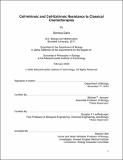| dc.contributor.advisor | Michael T. Hemann and Douglas A. Lauffenburger. | en_US |
| dc.contributor.author | Dalin, Simona S. | en_US |
| dc.contributor.other | Massachusetts Institute of Technology. Department of Biology. | en_US |
| dc.date.accessioned | 2020-05-26T23:14:04Z | |
| dc.date.available | 2020-05-26T23:14:04Z | |
| dc.date.copyright | 2020 | en_US |
| dc.date.issued | 2020 | en_US |
| dc.identifier.uri | https://hdl.handle.net/1721.1/125469 | |
| dc.description | This electronic version was submitted by the student author. The certified thesis is available in the Institute Archives and Special Collections. | en_US |
| dc.description | Thesis: Ph. D., Massachusetts Institute of Technology, Department of Biology, 2020 | en_US |
| dc.description | Cataloged from student-submitted PDF version of thesis. | en_US |
| dc.description | Includes bibliographical references. | en_US |
| dc.description.abstract | Resistance is a constant presence in chemotherapy treatment. The very action of these therapeutic compounds causes resistance to these drugs. There are two modes of resistance to chemotherapy: the cancer cells themselves can undergo modifications that result in resistance, known as cell-intrinsic resistance. Alternatively, the non-malignant cells surrounding the tumor can undergo modifications that result in chemo-protection of the nearby malignant cells, known as cell-extrinsic resistance. Both of these modes of resistance have been extensively studied in the lab, however our knowledge is not advanced enough to subvert chemotherapy resistance in the clinic. To further our knowledge of chemotherapy resistance with the ultimate goal of reducing or eradicating this public health challenge, I have studied mechanisms of cell-intrinsic and cell-extrinsic resistance. I first studied how to best choose the drugs in a combination regimen to reduce the emergence of chemotherapy resistance. | en_US |
| dc.description.abstract | I created over 100 cell lines resistant to front-line cytotoxic chemotherapies and surveyed collateral responses to acquisition of resistance. Previous research in bacteria and targeted cancer chemotherapeutics suggested that collateral effects of resistance to one drug can result in both resistance to a second drug, termed collateral resistance, as well as sensitivity to a second drug, termed collateral sensitivity. In contrast, I found that collateral sensitivity to resistance to classical chemotherapies is rare or nonexistent. Surprisingly, I also found that collateral responses to resistance to a single agent are not uniform, and are instead heterogeneous. Both of these results suggest that designing combination regimens with the objective of reducing resistance is not straightforward, and motivate more work to understand the forces at play. next studied the role of the microenvironment on gemcitabine resistance in pancreatic cancer. | en_US |
| dc.description.abstract | Previously known mechanisms of microenvironment mediated resistance rely on paracrine signaling via heat-labile biomolecules such as cytokines and RNAs. In contrast, I found that pancreatic stromal cells secrete a heat-insensitive compound that confers gemcitabine resistance. I performed a series of biochemical experiments which identified this compound as deoxycytidine. This knowledge suggests that combining inhibition of deoxycytidine synthesis with gemcitabine treatment could increase gemcitabine efficacy. | en_US |
| dc.description.statementofresponsibility | by Simona Dalin. | en_US |
| dc.format.extent | 121 pages | en_US |
| dc.language.iso | eng | en_US |
| dc.publisher | Massachusetts Institute of Technology | en_US |
| dc.rights | MIT theses are protected by copyright. They may be viewed, downloaded, or printed from this source but further reproduction or distribution in any format is prohibited without written permission. | en_US |
| dc.rights.uri | http://dspace.mit.edu/handle/1721.1/7582 | en_US |
| dc.subject | Biology. | en_US |
| dc.title | Cell-Intrinsic and cell-extrinsic resistance to classical chemotherapies | en_US |
| dc.type | Thesis | en_US |
| dc.description.degree | Ph. D. | en_US |
| dc.contributor.department | Massachusetts Institute of Technology. Department of Biology | en_US |
| dc.identifier.oclc | 1155052463 | en_US |
| dc.description.collection | Ph.D. Massachusetts Institute of Technology, Department of Biology | en_US |
| dspace.imported | 2020-05-26T23:14:03Z | en_US |
| mit.thesis.degree | Doctoral | en_US |
| mit.thesis.department | Bio | en_US |
